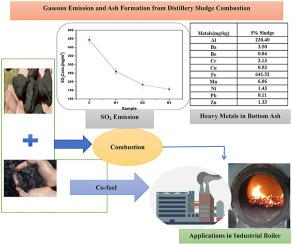Energy ( IF 9 ) Pub Date : 2021-01-21 , DOI: 10.1016/j.energy.2021.119871 Prashik Manwatkar , Lekha Dhote , Ram Avtar Pandey , Anirban Middey , Sunil Kumar

|
Co-combustion of coal with distillery sludge waste (DSW) was investigated in a laboratory-scale Drop Tube Furnace (DTF) plant. This study examined the feasibility of combustion of sludge with coal using preliminary testing methods, such as thermogravimetric, ultimate and proximate analysis followed by combustion experiments. These methods helped to identify burnout efficiency, emitted pollutants, and metal constituents in the bottom/fly ash. The ratios of coal to DSW in the feed was 90:10%, 95:5%, 98:2% and 100:0% by dry weight basis. The vibrator feeder and airflow rate were set at the rate of 1.5 kg/h and 150 L/min with slightly negative pressure. The concentration of gases (i.e. nitrogen oxides (NOx), sulphur dioxide (SO2), carbon mono-oxide (CO), hydrocarbon (HC)) and particulate matter (PM) on DSW combustion was measured and compared with the combustion of coal. The pattern of gaseous emission and combustion efficiency showed high degree linear combinations through Pearson’s correlation coefficient. The decrease in the concentration of PM (76.67 ± 10.41 mg/m3 to 91.33 ± 17.62 mg/m3) and SO2 (444 ± 20.63 mg/m3 to 156.60 ± 12.26 mg/m3), increase in the concentration of NOx (136 ± 15.41 mg/m3 to 387 ± 15.2 mg/m3) and CO (26.15 ± 5.36 mg/m3 to 824.32 ± 43.70 mg/m3), unburnt carbon percentage in the fly ash, and clinker formation were taken into account to optimum the sludge proportion in the DTF under a given set of combustion conditions. Most importantly, an increase in sludge quantity (i.e. 2%, 5%, and 10%) showed a decrease in the burnout efficiency (98.41%, 95.91%, and 92.6%, respectively).
中文翻译:

滴管炉中混合煤的酒厂污泥燃烧及排放特性
在实验室规模的滴管炉(DTF)工厂中研究了煤与酒厂污泥废物(DSW)的共燃烧。这项研究使用初步的测试方法(例如热重分析,最终分析和近似分析,然后进行燃烧实验)检验了煤燃烧污泥的可行性。这些方法有助于确定燃尽效率,排放的污染物以及底灰/飞灰中的金属成分。进料中煤与DSW的比率以干重计为90:10%,95:5%,98:2%和100:0%。将振动器进料器和气流速率设定为1.5 kg / h和150 L / min的速率,并稍加负压。气体(即氮氧化物(NOx),二氧化硫(SO 2),测量了DSW燃烧中的一氧化碳(CO),碳氢化合物(HC))和颗粒物(PM)并与煤的燃烧进行了比较。气体排放和燃烧效率的模式通过皮尔逊相关系数显示出高度线性组合。PM(76.67±10.41 mg / m 3到91.33±17.62 mg / m 3)和SO 2(444±20.63 mg / m 3到156.60±12.26 mg / m 3)的浓度降低, NO x(136±15.41 mg / m 3至387±15.2 mg / m 3)和CO(26.15±5.36 mg / m 3至824.32±43.70 mg / m 3),粉煤灰中未燃烧的碳百分比以及熟料的形成,以在给定的一组燃烧条件下优化DTF中的污泥比例。最重要的是,污泥量的增加(即2%,5%和10%)表明燃尽效率降低(分别为98.41%,95.91%和92.6%)。



























 京公网安备 11010802027423号
京公网安备 11010802027423号